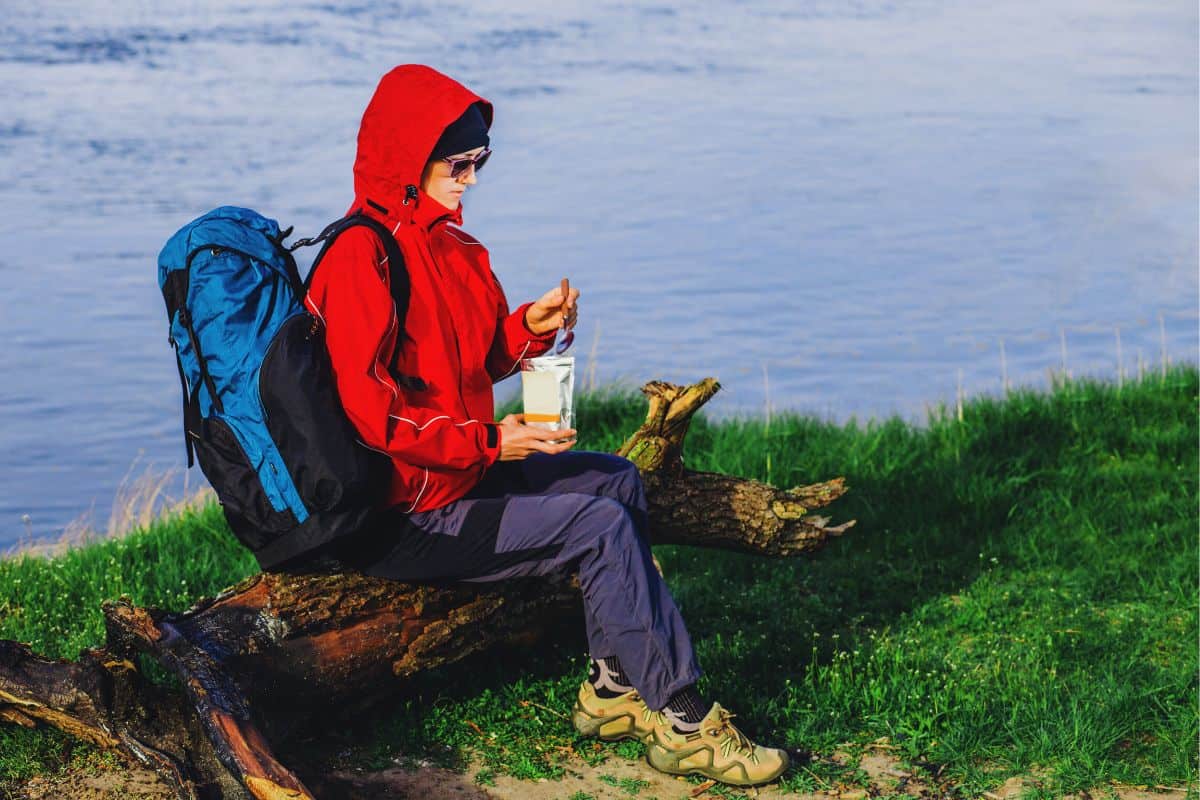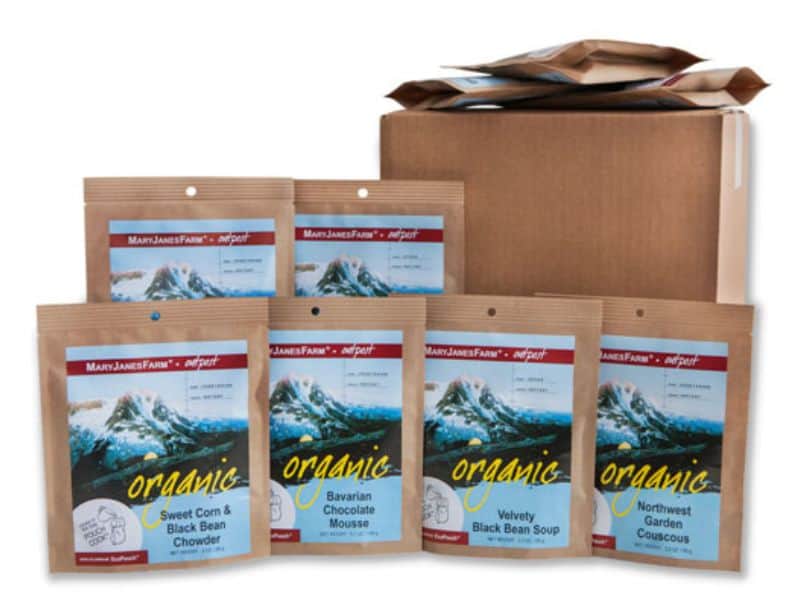When you’re on a long camping expedition, trail mix alone won’t cut it. You’ll need something more filling and nutrient-dense to replenish all that lost energy spent hiking and setting up camp. The quickest way to satisfy your hunger is to open a freeze-dried meal pack and add boiling water.
Fortunately for backpackers, the taste of freeze-dried camping foods has significantly improved in recent years. After trying and tasting the top freeze-dried food brands, we’ve chosen Backpacker’s Pantry as our top pick for backpacking food. We also highly recommend Mountain House, Omeals, Good To-Go, Alpine Aire, Mary Jane’s Farm, and Peak Refuel.
In this article, we’ll discuss how freeze-dried food is made, what its benefits and nutritional value are, and the importance of drinking more water while consuming freeze-dried meals. We’ll also explore the comparison between freeze-dried and dehydrated food, where to purchase it, and the feasibility of freeze-drying your own food at home.
Table of Contents
At a Glance: Quick Recommendations
-
Editor’s Choice:
Backpacker’s Pantry
“A great range of entrees, main courses, and desserts that exceeded expectations in the taste test.” -
Best Value:
Mountain House
“Lightweight, two-serving, great-tasting meals with an impressive 30-year shelf life.” -
Most Convenient:
Omeals
“The heating element included with these meals allows you to travel without a stove or cooking fuel.” -
Best Dehydrated Food:
Good To-Go
“A wide selection of yummy, certified gluten-free, and pescatarian-friendly meals.” -
Most Filling:
Alpine Aire
“A little on the heavy side but ideal for the extra-hungry camper or hiker.” -
Best Organic:
Mary Jane’s Farm
“Exclusively vegan and vegetarian options made with 100% certified-organic ingredients.” -
Best for Carnivores:
Peak Refuel
“Hearty, protein-rich meals made with 100% real meat.”
Top Choices by Category
Budget: Mountain House and Omeals
Organic: Mary Jane’s Farm
Variety: Backpacker’s Pantry
Filling: Alpine Aire and Peak Refuel
How Is Freeze-Dried Food Made?
To freeze dry fresh or cooked foods, manufacturers initially place the food in a drying chamber and lower the temperature to at least -40°F. Then, they gradually raise the chamber’s temperature, which helps form a vacuum around the food.
The point of this process is to get the ice on the food to change directly into a gas and evaporate. Once this process is complete, the food has been “suspended” in a dry state that can only be activated once you add water to it.
The modern history of freeze-dried foods dates back to World War II. Scientists were looking for a cheap way to provide millions of troops with a filling and lightweight food source that didn’t spoil. During the war, researchers also used the same principles of freeze-drying to preserve blood and essential medicines. Most people today probably associate freeze-drying foods with NASA astronauts.
What are the best freeze-dried food brands for Camping & Backpacking?
The following list highlights our top recommendations for the best freeze-dried food company, with Backpacker’s Pantry coming out on top.
- Backpacker’s Pantry
- Mountain House
- Omeals
- Good To-Go
- Alpine Aire
- Mary Jane’s Farm
- Peak Refuel
Backpacker’s Pantry
Editor’s ChoiceWith their extensive meal catalog catering to all types of dietary restrictions, the Backpacker’s Pantry earns our editor’s choice award. They offer a variety of gluten-free, non-dairy, no-peanut, and no-soy dishes, as well as low-sodium options for those concerned about salt content.
All Backpacker’s Pantry basic entrée packets serve two people and come in a mylar serving pouch with Ziploc tops. These two-person meals require 2 ¼ cups of hot water and between 15 to 20 minutes to cook through. For those traveling in larger groups, Backpacker’s Pantry has many larger packets and canisters that can feed anywhere between four to 18 people.
As for flavors, Backpacker’s Pantry has one of the most extensive catalogs. Just to give you a sense of Backpacker’s Pantry’s diversity, here are a few of the best backpackers pantry meals: Cajun rice with chicken, coconut curry with beef, Jamaican jerk rice with chicken, freeze dried veggies, and pesto salmon with pasta. Backpacker’s Pantry pad thai is a team favorite here at My Open Country!
In addition to entrées, Backpacker’s Pantry has plenty of small snacks, desserts, breakfasts, and side dishes available for purchase. Some of the top items in these categories include dark chocolate cheesecake, garlic mashed potatoes, Indian rice pudding, and organic olive oil.
Most two-person packets only weigh around six ounces, so you shouldn’t have any problems taking these meals on long trips. Also, Backpacker’s Pantry items have a respectable seven-year shelf life.
PROs
- Wide array of food choices for people with dietary restrictions
- Diverse catalog of foods that includes Italian, Asian, Tex-Mex, and Caribbean
- Easily customizable for small or large groups
- Seven-year shelf life
- Freeze-dried fruits and vegetables also in catalog
CONs
- You need 2 ¼ cups of boiled water to make one regular meal
- Utensils not included
Bottom-Line: Healthy, wholesome, and hearty freeze-dried camping meals to suit every palate and diet.
Mountain House
Best ValueFor an impressive value-to-taste ratio, Mountain House freeze-dried meals hit the spot. Specializing in meaty freeze-dried dishes intended to serve two campers per packet, each pouch requires two cups of boiling water and about 15 minutes to cook through.
Carnivores won’t have any issues finding something good in Oregon-based Mountain House’s product line, which includes yummy freeze-dried meat meals like beef stroganoff, lasagna with meat sauce, and chicken breast with mashed potatoes. MH also offers a good variety of breakfast dishes like granola with milk and blueberries, biscuits with gravy, and a breakfast skillet.
For those out there who can’t make up their mind which Mountain House packet to taste first, the company offers special emergency packets with a good sampling of their products. Don’t worry about adding too much weight to your backpack with these packets. Each Mountain House pouch only weighs an average of three ounces.
One nice feature of the Mountain House freeze-dried packets is that they have one of the longest shelf lives in the industry: 30 years. This makes Mountain House’s foods a superb option for people who want to stock up on freeze-dried options for years of hiking or emergency food for when the SHTF.
If you’re heading on a longer trip, or just like a little variety, check out the Mountain House Essential Bucket, which contains a total of the 22 best mountain house meals in one handy (if large!) package.
A slight negative for Mountain House is that they use more preservatives than other brands. People who have allergic issues or problems with tons of food additives might want to look for another product. On the positive side, many of these packets have low sodium counts and are high in protein.
PROs
- Two servings per container
- High protein content
- Long-term, 30-year shelf life
- Average weight of three ounces per packet
- Mountain House Essential Bucket offers even better value
CONs
- Mountain House uses a few food additives in its products
- Two cups of boiled water required to make one meal
- Not many vegetarian options
Bottom-Line: Mountain House packets are ideal for people who want to prepare for a survival scenario and enjoy dishes with plenty of meat.
Omeals
Most ConvenientPackaged with its own heating element and utensils, Omeals earns our title for the most convenient freeze-dried meals. Simply open the main bag, tear the heating element, place it inside with three to five ounces of water, let it sit for five minutes, then enjoy!
In addition to the heating element, Omeals provides you with all the utensils you need to enjoy their meals in the wild, so you can leave your spork at home! These conveniences make a huge difference at the end of a long day on the trails and cement Omeals as by far the most hassle-free freeze-dried meals out there.
Omeals is a Florida-based company that specializes in spicy dishes mostly inspired by Italian or Southwestern cuisine. Most of Omeals’s packets weigh about ten ounces and are single-serving, designed to feed one person per container.
Omeals aren’t cheap, granted, but it’s hard to quibble given just how convenient they are. We should also mention that, as far as taste goes, they’re up there with the best of them, particularly if you’re a fan of a good, satisfying, hearty meal after a day’s hiking!
A few of Omeals’ top sellers include pasta Fagioli, southwest chicken, and vegetable stew with beef. There are also some breakfast options in Omeals’ catalog including oatmeal and hashbrown potatoes.
For vegetarians, Omeals does offer a vegetarian chili and cheese tortellini in tomato sauce, but this company doesn’t exclusively cater to vegetarians. Omeals also doesn’t have many options for people with special food allergies like celiac disease.
At the time of writing, Omeals doesn’t offer sides or desserts. And for snacks, you only have three different cheese bites to choose from (all of which, however, are darned tasty!).
PROs
- Heating element, utensils, and napkin included in the packaging
- No need to boil water
- Only takes five minutes to heat up
- Good selection of dishes from Southwestern and Italian cuisines
CONs
-
- Relatively low three-year shelf life
- No sides or desserts available
- Not many options for vegetarians or vegans
-
Bottom-Line: Anyone traveling to extremely cold or rainy areas or new campers not experienced in building fires in the wild will appreciate Omeals’ convenient packaging.
Good To-Go
Best Dehydrated FoodRanging from Italian to Thai cuisine, Maine-based company Good To-Go provides an excellent selection of high-quality dehydrated food boxes.
Most Good To-Go packages weigh 6.6 ounces and feed two people per package with the average shelf life for meals being four years.
All of their products are certified gluten-free and pescatarian-friendly. So, if you only eat seafood or have celiac disease, you shouldn’t have a problem with Good To-Go’s range of products. Note, however, that all Good To-Go foods are made in a facility that also handles peanuts, dairy, eggs, and wheat.
Each packet requires 7 ounces of boiled water to prepare and you can dump boiled water directly into the bag and zip it up immediately. Manufacturers say it then takes about 20 minutes before your meal is ready to eat.
Another pro for Good To-Go foods is that they don’t rely on chemical additives or preservatives. When you see Good To-Go’s ingredients, you’ll be able to recognize and pronounce most of the names on the list. Good To-Go executives are also proud their products have less sodium than most of the competition. Their most popular product, Thai curry, has 500mg of sodium per serving.
For those who like Asian cuisine, try Good To-Go’s popular Thai curry, pad Thai, or Korean bibimbap. Campers more in the mood for Italian fare can pick up marinara with penne or herbed mushroom risotto. Good To-Go also offers diverse meals like smoked three-bean chili, Indian vegetable korma, and Mexican quinoa bowl.
In addition to buying the Good To-Go meals on their own, you can purchase “weekender packs.” The weekender packs include two of the meals listed above as well as an easy-to-make breakfast option like oatmeal or granola.
PROs
- About six ounces per packet
- Eight exotic options to choose from
- Gluten-free, pescatarian-friendly, and non-GMO
- Only requires seven ounces of boiling water
CONs
- Veggie only
- Four-year shelf life is not as long as other brands
- Foods are manufactured in a facility with eggs, nuts, and wheat
Bottom-Line: Health-conscious hikers who place a high priority on the quality of ingredients used in their meals will most enjoy Good To-Go’s diverse range of products.
Alpine Aire
Most FillingIf you tend to have a larger appetite than most, we found Alpine Aire to be the most filling option.
Alpine Aire has a good variety in its catalog, but most fall into these three categories: Asian, Tex-Mex, and Italian. Some of its signature meals include: turkey with mashed potatoes and gravy, mountain chili, spaghetti marinara with mushrooms, and pineapple orange chicken. Most Alpine Aire packets have an average shelf life of five years.
Besides entrées, Alpine Aire offers a few desserts and breakfasts like strawberry granola with milk and chocolate mudslide. There aren’t, however, many sides offered in Alpine Aire’s catalog.
Alpine Aire’s entrée packets hover around the nine-ounce mark and can feed two people. One nice thing about each packet’s design is that there are clear measurement lines on the side of the bag. On the back of the bag, you’ll see how much boiling water your particular packet requires. Once you have your water boiled, simply pour it up to the line on the side.
Anyone going on a longer trip can order Alpine Aire’s seven-day packets. There are both meat and vegetarian-friendly seven-day packets to choose from. We should note, however, that Alpine Aire doesn’t offer a huge selection of vegetarian-friendly entrées.
PROs
- Three different cuisine styles to choose from
- Clear measurements on the side of the packet
- Nine ounces or less per packet
CONs
- Not many side dishes or vegetarian options
- Shelf life of five years (not as long as other products)
Bottom-Line: Campers looking for hearty and spicy meals who don’t want to do any guesswork when measuring out their boiling water should take a peek at Alpine Aire’s catalog.
Mary Jane’s Farm
Best OrganicThe main feture that sets Idaho’s Mary Jane’s Farm apart is that all of its products are USDA-certified organic. When reviewing the ingredient lists, you’ll be hard-pressed to find any unpronounceable additives or chemicals.
Not only does MJF cater to the organic crowd, but it’s also one of the few companies that have exclusively vegetarian and vegan options.
Some of the company’s popular meals include kettle chili, creamy potato soup, and Santa Fe pasta. You can also order from Mary Jane’s Farm’s breakfast list, which includes favorites like breakfast frittatas and “bacon-less bacon” egg scramblers.
The average weight of each Mary Janes Farm’s packet is just three ounces, which is one of the lightest on our list. You’ll need about 1 1/3 cups of boiling water to make these one-person entrées. The average time you need to let these entrées sit is about seven minutes.
Note that Mary Janes Farm’s packets don’t have zip tops like most other products. You’ll have to rip open the top of your entrée completely, which makes it difficult to preserve any leftovers.
People who are looking for meaty meals won’t find much in Mary Janes Farm’s catalog. This company was designed for campers with dietary restrictions who place a high priority on the organic status of their products.
PROs
- Plenty of vegetarian and vegan options
- USDA certified organic
- Only three ounces per entrée bag
CONs
- Bags don’t have Ziploc tops
- No meat options
Bottom-Line: If you’re a particular eater looking for high-quality freeze-dried, organic, and vegetarian-friendly food, look no further than Mary Jane’s Farm.
Peak Refuel
Best for CarnivoresPeak Refuel’s protein-rich freeze-dried meals are the ideal choice for campers and backpackers who prefer a meatier main course.
The top-rated meals in Peak Refuel’s catalog include a chicken alfredo pasta, three-bean chili mac, chicken pesto pasta, and hearty beef stroganoff. Most of these meals weigh five ounces or less, serve two, can be cooked in around 10 minutes, and pack between 40 and 60 grams of protein.
The brand’s main selling point is that its meals are made with 100% real meat (with no meat fillers), which isn’t always the case with competitor brands. All products in the range are also non-GMO and are both freeze-dried and packaged in the USA.
In addition to meals, Peak Refuel has a smaller variety of desserts and breakfast items. A few of the options you could indulge in include strawberry granola, breakfast skillet, and brownie bites.
PROs
- Filling meals for two
- Average weight of five ounces per packet
- Only 10 ounces of boiling water and 10 minutes needed to prepare
- High in protein
CONs
- Not designed for vegetarians
- Not certified gluten-free
Bottom-Line: Hikers looking for protein-packed meals filled with meat, sauces, and Tex-Mex spices can’t go wrong with a Peak Refuel packet.
What are the benefits of freeze-dried meals for Backpackers?
The benefits of using freeze-dried meals in the wild all have to do with convenience. With a few freeze-dry food packs in your backpack, there’s no need to worry about hunting for food, food storage, or cooking when you reach your campsite. Additionally, most food packs are lightweight and won’t occupy much space in your backpack.
Another great feature is their long shelf life. You can order a whole packet of your favorite freeze-dry food products years in advance of your hiking treks and they will still be good.
By the way, it’s a good idea to include a few backpacking freeze-dried food packets or freeze-dried fruit in your first-aid kit. In a survival scenario, freeze-dried emergency food packs offer a reliable way to keep your energy up. While a clean source of water should be your top priority, freeze-dry foods can significantly boost your energy levels and stave off hunger.
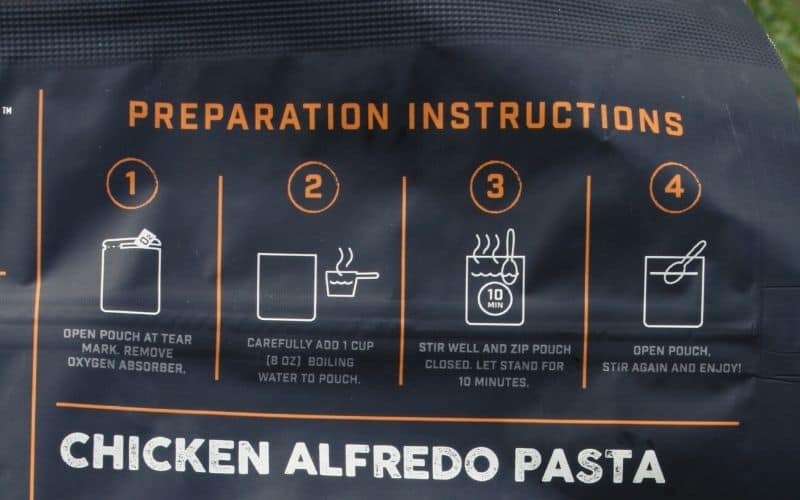
Is freeze-dried food healthy?
Since all the vitamins and minerals are preserved in the freeze-drying process, there isn’t much distinction between the health benefits of freeze-dried foods versus a fresh meal, whether you’re eating green beans or cooked meats. In particular, research has found no major differences between the levels of fiber and antioxidant levels in freeze-dried and fresh food.
The major difference between freeze-dried and raw foods is in the number of calories. Nutritionists have discovered that calories (per gram) are higher due to the lack of water content.
Interestingly, on average even the best dehydrated foods are less nutrient-dense than freeze-dried foods. Researchers say the dehydration process breaks down more vitamins. A few vitamins you may be lacking in dehydrated foods include vitamin A, vitamin C, and B-complex vitamins.
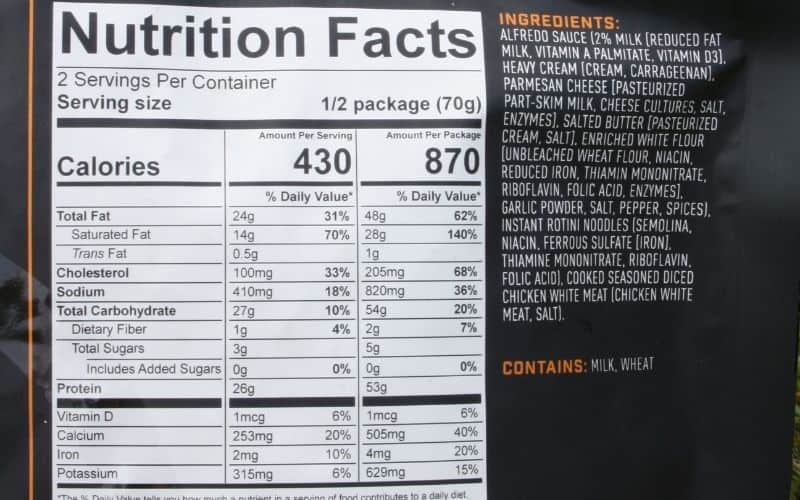
Should you drink more when eating freeze-dried food?
One thing to keep in mind when eating freeze-dried foods is to increase your water intake. Since these meals have had most of their moisture removed to prevent spoilage, your body will need to hydrate the food during digestion. Additionally, the higher sodium content may adversely impact your hydration levels.
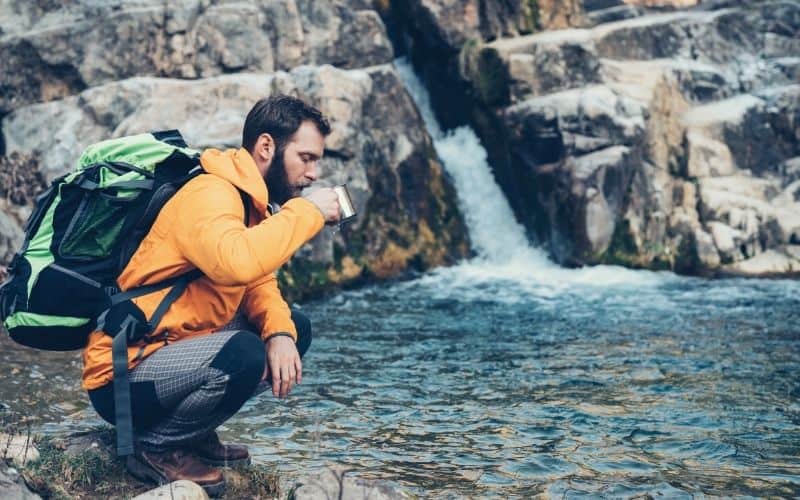
Is Freeze Dried Food better than Dehydrated Food?
While somewhat subjective, freeze-dried food surpasses dehydrated food in terms of longer shelf life, reduced moisture content, and decreased weight.
While the techniques of freeze-drying food have only been perfected in modern times, the process of dehydrating food has been around for thousands of years. We have records of many ancient societies drying out fruits and veggies to preserve their freshness.
In olden times, people used insulated areas and a fire to dry out their foods. Today, there are dehydrating machines designed to get rid of water by heating up the food and continuously circulating hot and dry air.
While freeze-dried and dehydrated foods have many similarities, there are a few reasons campers prefer freeze-dried products.
First, freeze-dried foods were designed to remove as close to 100% moisture as is humanly possible. Dehydrated foods, however, could retain as much as 10 percent moisture content when you buy them. The lower moisture content in freeze-dried foods is the major reason they have a longer shelf life than dehydrated foods.
Another advantage freeze-dry foods have over dehydrated foods is that they weigh less. You’ll only add a few ounces to your travel kit with freeze-dried food packages. By comparison, many dehydrated food packets are measured in pounds.
The downside to freeze-dried meals though is the need to carry a backpacking stove and fuel with you to prepare these dishes.
Further reading: Check out our guide to planning your backpacking meal requirements.
Where can You buy freeze-dried food?
The leading freeze-dried food brands can be found at most major outdoor retailers such as R.E.I., Moosejaw, and Backcountry. Additionally, many freeze-dried food companies sell their premade meals directly.
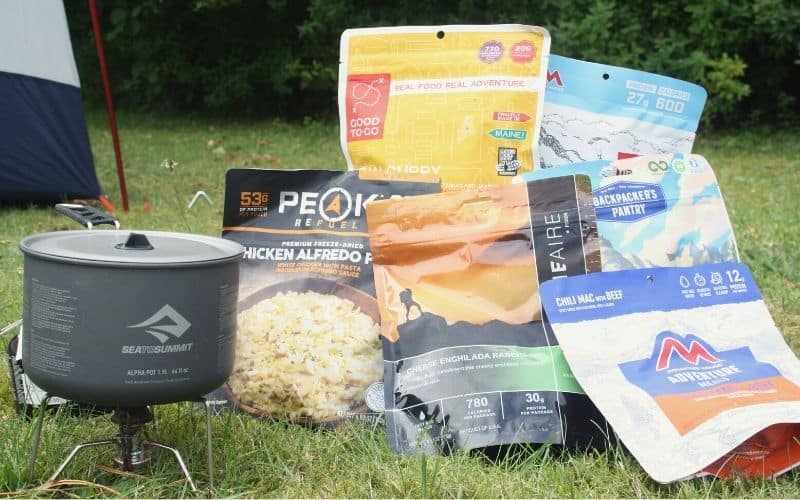
Should You Buy Your Own Freeze Drying Machine?
For frequent hikers, it might be tempting to cook and freeze-dry food at home to match your dietary preferences, but it could take several years of hiking before you break even.
Anyone who’s dead set on homemade meals might want to consider investing in more affordable dehydration devices. For casual backpackers, however, it’s far more cost-effective and convenient to order freeze-dried meals from reputable companies rather than buying a machine.
Best Freeze Dried Meals For Backpacking And Camping: The Verdict
While we all have food preferences, the diverse selection of tasty, nutritious, and convenient meals from Backpacker’s Pantry has something to cater to everyone’s diet and tastes
Backpacker’s Pantry meals are a little on the pricey side, we know. However, a few budget alternatives are available, the best of which has to be those from Omeals. Not only are these meals super tasty and affordable, but the included heating element also saves you the hassle of carrying a stove and gas canister, making them the most convenient option by a country mile.
If you liked this article, let us know in the comments box below! And if you’d like to share it with your friends, please do!
